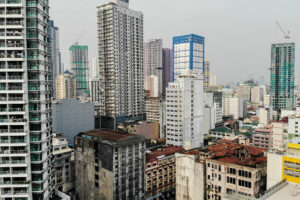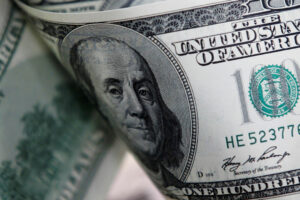By Luisa Maria Jacinta C. Jocson and Aubrey Rose A. Inosante, Reporters
THE weaker-than-expected economic growth in the third quarter will allow the Bangko Sentral ng Pilipinas (BSP) to continue cutting rates, analysts said, though this outlook is clouded by the Federal Reserve’s own moves under a Trump presidency.
“I think the result certainly means that the BSP’s monetary policy easing cycle will continue for the foreseeable future, with another 25-basis-point (bp) cut at least in the December meeting,” Pantheon Chief Emerging Asia Economist Miguel Chanco said in an e-mail.
The Philippine economy grew by 5.2% in the July-to-September period, sharply slowing from the 6.4% growth in the second quarter and 6% a year earlier.
This was also the weakest gross domestic product (GDP) growth in five quarters or since the 4.3% expansion in the second quarter of 2023.
Patrick M. Ella, economist at Sun Life Investment Management and Trust Corp., said the latest GDP print “helps cement the BSP to continue its rate cut cycle or even accelerate it next year if topline GDP remains slowing.”
Since August, the central bank has so far reduced the target reverse repurchase (RRP) rate by a total of 50 bps, bringing the benchmark to 6%.
Its final policy review this year is set for Dec. 19, with markets widely anticipating another 25-bp cut as signaled by BSP Governor Eli M. Remolona, Jr.
Finance Secretary Ralph G. Recto said they would want to cut rates further but are “mindful” of inflation expectations and the US Federal Reserve’s actions.
“There’s thought the Fed will continuously reduce interest rates, so if they do, then there’s a possibility we could also, but we’re also looking at the exchange rate,” he told BusinessWorld on the sidelines of a budget hearing last week.
However, Mr. Recto said the central bank is unlikely to deliver bigger-sized rate cuts. He said the Monetary Board may keep quarter-point increments, similar to the BSP chief’s own signals.
Mr. Remolona earlier said they would only consider 50 bps or higher worth of rate cuts in a “hard-landing scenario.”
“At the moment, we are not in the ‘hard-landing’ scenario (for the US and Philippine economies respectively),” Mr. Ella said.
“I think the improvement in consumption in the third quarter versus the first and second quarters is a good sign, we just need a few more quarters of these. Going forward, inflation and interest rates are coming down, so we can expect improvement in consumption down the road,” he added.
TRUMP’S IMPACT ON FED
Analysts also noted the impact of the US president-elect Donald J. Trump on the US central bank’s actions and ultimately, the BSP.
“We previously thought that a weak third-quarter GDP print would open the door for larger 50-bp rate cuts in December,” Mr. Chanco said.
“But Donald Trump’s victory has complicated that scenario, as our house view is now that the Fed will keep the pace of easing to 25 bps in view of the inflationary risks in the US posed by the President-elect’s tariff proposals.”
Mr. Trump is set to return as president on Jan. 20 after beating current Vice-President Kamala Harris in the presidential elections last week.
The Fed will likely “ease more gradually” next year, Mr. Chanco said, which may “constrain the BSP’s options in terms of going for more aggressive cuts.”
Mr. Remolona earlier said it was possible to deliver a total of 100 bps worth of rate cuts in 2025.
The Federal Reserve cut interest rates by a quarter of a percentage point on Thursday.
Nomura Global Markets Research said in a report that the Trump win may dampen overall economic growth amid expectations of higher tariffs, weaker global demand and policy uncertainty.
“We maintain our forecast for GDP growth to improve only marginally to 5.6% year on year in 2024 from 5.5% last year, before picking up to 6.1% in 2025, although we now see some downside risks from Trump’s win in the US election,” it said in a report.
“We still think BSP is unlikely to be more aggressive with 50-bp clips, in part because the substantial reserve requirement ratio (RRR) cut is already providing additional easing,” it added.
Nomura expects the Philippine central bank to cut by a total of 100 bps next year.
On the other hand, Mr. Ella said that the Trump win is unlikely to significantly impact monetary policy.
“On the Trump win, I don’t think there are risks to interrupt the BSP easing cycle. One, the BSP will respond more to commodity or food price risks,” he said.
“Second, remember that Trump favors low rates. At one point in his first term, he wanted the Fed to cut rates to negative territory but the Fed resisted this call and just kept rates on a mildly rate hike path.”
SLOWING GROWTH
Meanwhile, the Philippine economy is unlikely to grow by 6.5% in the fourth quarter to meet the low end of the government’s 6-7% growth target this year, analysts said.
“Growth momentum slowing down. Hopefully, the fourth quarter of 2024 should see a positive support for consumption but [I] am looking at a full growth of 5.8%,” Jonathan L. Ravelas, senior adviser at professional service firm Reyes Tacandong & Co., said in an e-mailed statement over the weekend.
For the first nine months of the year, GDP growth averaged 5.8%.
Mr. Ravelas said that the government should ramp up spending and support more non-monetary measures to address inflation, noting this has slowed the recovery in consumer spending.
He said another 25-bp cut by the BSP should help support growth.
However, fourth-quarter agriculture output is also expected to decline due to adverse weather conditions, he said.
Agriculture, forestry and fishing shrank by 2.8% in the third quarter, a reversal of the 0.9% growth posted a year ago. The sector, which accounts for around a tenth of Philippine economic output, was battered by typhoons and storms in the third quarter.
Mr. Ravelas projected GDP to grow by 6.5% in 2025, driven by the government’s infrastructure push, rate cuts worth 100 bps by the BSP, and a recovery in consumption.
Meanwhile, Jesus Felipe, distinguished professor and research fellow at the De La Salle University (DLSU) School of Economics, said it is also “very unlikely” that the fourth-quarter growth will reach 6.5%. He sees 6.2% GDP growth for the October-to-December period.
“We forecast growth in 2024 to be 5.9%,” Mr. Felipe told BusinessWorld in an e-mail statement. “The only way growth in Q4 would be higher than 6.2% (and hence annual growth higher than 5.9%) is if the government incurs massive spending.”
The economy has recovered from the pandemic, but real wages are still catching up and getting to 2019 levels, he said.
“This is why private consumption has been subdued,” Mr. Felipe added.
Meanwhile, Pantheon Macroeconomics Mr. Chanco said the latest GDP print was a “painful reality check for the Philippine economic recovery.”
“We’re sticking to our 5.4% full-year growth forecast for 2024 — implying a further drop in Q4 to 4.4% — even though the Q3 print was above our below-consensus 4.8% projection,” he said in a report.
Mr. Chanco said he expects “BSP to continue easing policy for the foreseeable future, given the current setting remains very tight in real terms.”
“But we have pared back our expectations on the aggressiveness of this easing cycle, as the Fed is no longer likely to be as gung-ho in view of the inflationary impact of President-elect Donald Trump’s proposed tariffs,” he added.
He now sees a 25-bp cut by the BSP, from his earlier forecast of 50 bps. For next year, he sees 100 bps worth of easing, down from 150 bps previously forecast.
Jojo Gonzales, research analyst at Philippine Equity Partners, Inc. said the third-quarter GDP growth was worse than expected but maintained the full-year estimate at 5.9%.
“We see private consumption growth improving further in fourth quarter alongside receding inflation, reduced unemployment, improved consumer confidence, and a hike in minimum wages that took effect in 3Q24,” Mr. Gonzales added.
Meanwhile, Mr. Gonzales said government expenditures “remaining subdued” as spending appeared to have been “front-loaded” in the first half of 2024, and may be flat in the fourth quarter.
Peter Lee U, dean of the University of Asia and the Pacific’s School of Economics, said GDP is unlikely to grow by 6.5% in the fourth quarter to meet the low end of the 6-7% target.
“Based purely on past trend when fourth growth rates were 7.9% in 2021, 7.1% in 2022, 5.5% in 2023,” he told BusinessWorld in a Viber Message.






